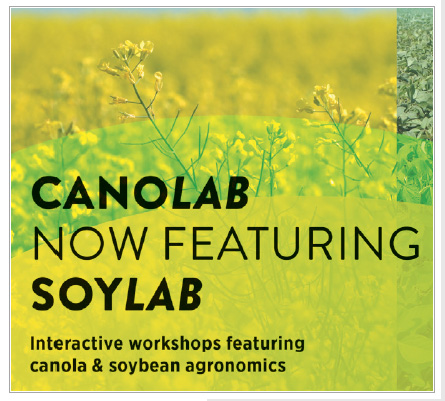Laura Schmidt, Extension Coordinator, MPSG
Manitoba Pulse & Soybean Growers joined the Manitoba Canola Growers Association for an interactive, two-day event in Brandon and Dauphin on March 14–15. SoyLAB joined canola sessions to bring farmers and agronomists hands-on information about soybean management. Eight sessions and more than 16 extension and research experts covered a wide range of topics.
Stand establishment was a focus for both crops and was paired with weed and disease management topics, focusing on Phytophthora root rot and white mould. Aphids and beneficial insects were explored in more detail. Inoculation and nodulation topics brought in researchers studying nitrogen and rhizobia dynamics. A dynamic station filled with great information, the inoculation and nodulation session highlights are provided below.
SOYLAB – Inoculation and Nodulation
INOCULATION
Nitrogen in soybeans is mainly supplied by a symbiotic relationship with the nitrogen-fixing bacteria, Bradyrhizobium japonicum, living within the soybean nodules. These N-fixing B. japonicum strains are not native to Manitoba and inoculation is used to introduce the bacteria into the soil. Native species of Bradyrhizobium exist in the soil but are incapable of forming nodules on soybeans.
During SOYLAB, Patricia Ordonez discussed the preliminary results of her ongoing, MPSG-funded study with Dr. Ivan Oresnik, looking at the persistence of B. japonicum in Manitoba soils and the influence of crop rotation on rhizobial and microbial populations. The frequency of soybean in the rotation can build up populations of rhizobia capable of nodulating soybeans. Her results indicate these rhizobia overwinter in Manitoba and soybeans following canola had lower B. japonicum populations than soybeans following wheat or corn.
In fields with little to no history of soybean, double inoculation with two inoculant formations or placement techniques is recommended to ensure adequate rhizobia is present in the soil to facilitate nodulation. Once soybeans have been established in the crop rotation, the amount of inoculant required may be reduced. To help determine the best inoculant strategies for your field, consult MPSG’s Soybean Fertility Fact Sheet.
STARTER N
One question was repeated at this station throughout SoyLAB: Would there be a yield or protein response to low rates of nitrogen early in the season? Dr. Navneet Brar investigated the effects of starter nitrogen (0–75 lbs/ac) on soybeans in her study with Dr. Yvonne Lawley. The thinking behind this project was with our cool, wet soils in Manitoba and the long time between seeding and when nitrogen fixation begins, that there might be a response to starter N. Ureide N analysis was used to assess the nitrogen contribution from biological N fixation.
Where higher N fertilizer rates were applied at planting, N fixation was reduced and the number of nodules at R1 and R5.5 decreased. However, there was no response in soybean yield nor protein with nitrogen applications. For well nodulated soybeans, it appears nitrogen fertilizer isn’t necessary.
ASSESSING NODULATION
How many nodules should a soybean have to maximize yield?
Regardless of the inoculant strategy used or field history, nodulation should be assessed on every field, every year. The ideal stage to check for adequate nodulation is at R1 to ensure the crop will have sufficient capacity to supply itself N during critical growth stages (R4–R5) to maximize yield.
Use a shovel to gently uproot soybean roots – nodules can be ripped off it the plants are not carefully pulled out from the ground. Cut the nodules open to determine if the rhizobia are actively fixing nitrogen.
If the inside of the nodules are pinkish-red, then biological N fixation is taking place. Leghemoglobin in the nodules, similar to hemoglobin in blood, is produced by the rhizobia during N-fixation and turns colour when exposed to oxygen.
Results from a recent MPSG study evaluating various inoculant products, rates, formulations and combinations found that at least ten nodules per plant at R4 was required to reach 90% of maximum yield (Figure 1).
What to do in the event of a nodulation failure was answered by John Heard from Manitoba Agriculture, taking a closer look at some of his work on rescue nitrogen applications.
At the advanced growth stage of R4, it would be too late to conduct a rescue nitrogen application should you suspect a nodulation failure. At R4 to R5, N fixation and N requirements for soybean have reached a maximum, accumulating 4.5 lbs N/ac each day (Figure 2).
A rescue application of nitrogen fertilizer should be made at R2–R3 and the fertilizer should be directed below the canopy, minimizing leaf burn which can reduce yield. Either a broadcast granular or liquid nitrogen fertilizer can be used as long as care is taken to minimize leaf coverage and application is made when rainfall is imminent, which is necessary to move the nitrogen into the root zone.
Figure 1. Relationship between number of nodules per soybean plant and relative yield.
Figure 2. Nitrogen accumulation by soybean.



